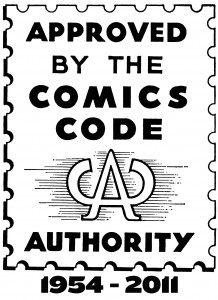 The Comics Code — the “guidelines” that resulted from United States Senate hearings that took place during the height of the Golden Age of comics and that are credited with the first major downfall of the comic book industry — to speak of these institutionally established rules is to recount literal horror stories of blatant mandated regulation, a perverse culture of moral panic, and ultimately “True Stories of Censorship.”
The Comics Code — the “guidelines” that resulted from United States Senate hearings that took place during the height of the Golden Age of comics and that are credited with the first major downfall of the comic book industry — to speak of these institutionally established rules is to recount literal horror stories of blatant mandated regulation, a perverse culture of moral panic, and ultimately “True Stories of Censorship.”
At this year’s NYCC, “Tales from the Code” was the topic of conversation among CBLDF Executive Director Charles Brownstein, former DC Comics Publisher Paul Levitz, and popular comics creator and historian Fred Van Lente. Along with a quick and dirty account of history of the code and a discussion of the negative impact that it had not only on the industry itself, but for those who chose to call it a professional home, the panelists also took the time to explain the unexpected and notable role the code had in shaping the comic book industry creatively and entrepreneurially into the unique entity that it has become today.
CBR’s Shaun Manning was on site to witness this lively affair. Citing reminiscences of the famously crafty way that EC Comics Publisher Bill Gaines reformatted his parody book MAD from a comic book to magazine to bypass regulation in the ’50s to accounts of how publishers like DC and Marvel strategically manipulated their art and content to fall within (but also overtly challenge) the code in the ’70s to tales of the Underground Comix Movement’s anarchical rise as a response to rejection from mainstream newsstand distribution channels through the ’80s, Manning described the panel as “part of the CBLDF’s education mission, exploring the history of censorship in comics and [its] resulting effects on culture.”
“Tales from the Code” was as much a discussion about the history of the code as it was an elaboration on the inception of the current, creatively free culture of comics itself. The speakers celebrated the persistence and perseverance of the comics form and its creators, continually reiterating the true ingenuity of the industry evident from the works that were produced in the turbulent, restrictive, and controversial times brought about by the code. It was this ingenuity that brought forth creator-owned content, that directly and continually demanded revision of the code, and ultimately gave birth to a unified community of fans and creators that could side-step traditional newsstand distribution (and the code) altogether — the modern comic shop and the modern direct market. As Brownstein aptly stated:
“[T]he Comics Code was all about the distribution. It was about what can go out on the newsstands. If you remove the newsstand from the equation, you no longer need the Code. It enabled new publishers to develop, to create other kinds of content that was speaking to an audience that already had passion for this material.”
To speak of the Comics Code is, without a doubt, to recount a bleak point in comics (and American) history. But as Brownstein, Levitz, and Van Lente remind us, to speak of the code is also to recount loving memories of all the (to quote the Senate Subcommittee hearing itself) “short courses in murder, mayhem, robbery, rape, cannibalism, necrophilia, sex, sadism, masochism, and virtually every other form of crime, degeneracy, bestiality, and horror” — all things that, though skewed and distorted by political rhetoric, heated moral jargon, and censorship, gave rise to an industry that flourishes on creativity, freedom of speech and expression, and ultimately a shared passion between like-minded fans and peers.
Probably the most apparent triumph of the comics industry over its own censorship was CBLDF obtaining full rights to the Comics Code Seal of Approval in 2011. As Manning writes:
“Marvel dropped the Code entirely in 2001, leaving DC and Archie as the last holdouts until 2011…The CBLDF received the intellectual property rights to the Comics Code Seal of Approval that same year, giving them control, ironically, of a badge of censorship.”
You can read Manning’s article here. The point of the panel was of course to present an entertaining glimpse into the history of the code and to learn how the comics industry adapted. More importantly, though, the take-away message was to urge comics fans to use their knowledge to initiate a conversation about the history of social regulation and to identify and combat forms of censorship being propagated even today in other creative industries.
We need your help to keep fighting for the right to read! Help support CBLDF’s important First Amendment work by visiting the Rewards Zone, making a donation, or becoming a member of CBLDF!
Contributing Editor Caitlin McCabe is independent comics scholar who loves a good pre-code horror comic and the opportunity to spread her knowledge of the industry to those looking for a great story.